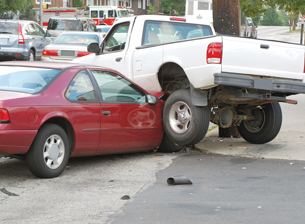Module 2
1. Module 2
1.8. Page 6
Module 2—The Conservation of Momentum in Isolated Systems
 Reflect and Connect
Reflect and Connect

© Losevsky Pavel/shutterstock
In traffic, when one car fails to stop or slow down for another car, a rear-end collision can occur. When this happens, some of the momentum of the moving car is transferred at the moment of impact to the car it strikes. The conservation of momentum can be used to describe how this happens. But it is not that simple; vehicles on a roadway are not an example of an isolated system. Frictional forces interact during and after the collision to bring all the vehicles to a stop. Therefore, the analysis of the momentum would be most useful for determining speeds immediately before and after the point of impact, and no more.
 Module 2: Lesson 1 Assignment
Module 2: Lesson 1 Assignment
Remember to submit the answers to D 5 to your teacher as part of your Module 2: Lesson 1 Assignment.
 Discuss
Discuss
Now that you know about the law of conservation of momentum, you can apply what you have learned to a number of simplified forensics engineering problems. Post your answers to these problems to the discussion area to see how your answers compare to those of other students.
A collision occurred when a 1500-kg car collided with a 15 000-kg truck initially at rest. After the collision, the vehicles locked together and moved with a combined velocity of 1.0 m/s, east.
D 1. What type of collision is described by this situation?
D 2. Use the law of conservation of momentum to solve for the velocity of the car, in metres per second, before the collision occurred.
D 3. Convert your answer from D 2 into kilometers per hour. The posted speed limit in this area was 25 km/h because it was designated for loading passengers and freight. Was the car speeding?
D 4. In answering this question you have made some assumptions. Knowing this, would those assumptions be grounds for reasonable doubt if there were a court case against the car’s driver due to damages caused by the collision? Post your answer to the discussion forum and read the other students’ postings.
D 5. Read the other students’ comments and then rewrite your own answer to D 4 and include a description of what you learned from the other students’ responses.
Discussion Scoring Guide
Discussion Scoring Guide
Principles involved: Conservation of momentum, isolated systems |
||||
Criteria |
Level 1 (Below Standard) |
Level 2 (Approaching Standard) |
Level 3 (Standard) |
Level 4 (Above Standard) |
Knowledge |
||||
Demonstrates understanding of the situation, physics principles and technology, and their connections. |
Demonstrates a vague and sometimes incorrect understanding of the physics principles involved. Obvious irrelevant or missing information. |
Demonstrates a basic understanding of the physics principles involved. May exhibit minor mistakes or vague information or application to the situation. |
Demonstrates a good understanding of the physics principles involved and applies them properly to the given situation. All necessary information is given. |
Demonstrates a superior understanding of the physics principles involved and their application to the situation. All applications are considered in detail. |
Reflection |
||||
The post shows reflection on one’s own and other students’ work. Contributes to the group discussion. |
Does not make an effort to participate. Seems indifferent to discussion. |
Occasionally makes meaningful reflections on the group’s efforts or discussions. Marginal effort is shown to become involved with the group or discussion. |
Frequently makes meaningful reflections on the group’s efforts and presents relevant viewpoints for consideration by the group. Interacts freely with group members. |
Regularly attempts to motivate the group discussion and delve deeper into concepts. Interacts freely and encourages all group members. |
Content and presentation of discussion summary |
||||
The information is logically arranged in a clear and concise manner. |
The information is poorly organized with many concepts implied. Irrelevant or rambling sentences make reading difficult. |
The information is somewhat organized with implied concepts. Excessive words or awkward sentences are used, which hinder reading. |
The information is well-organized and logically arranged. All concepts are explicitly explained. There are a few awkward but understandable sentences. |
The information is well- organized and very easy to understand. Well-worded sentences make reading pleasurable. |
 Reflect on the Big Picture
Reflect on the Big Picture

© Katherine Welles/shutterstock
Recall the collision of Kathy and Bill from the Big Picture section. Based on what you learned in this lesson, start to analyze this collision.
Open the document titled Module 2 Project and store it in your Physics 30 course folder. You will be required to add to it at the end of each lesson in Module 2 until it is complete and submit it to your teacher as your Module 2 Project for marks.
Answer the following question in your crash analysis document:
The mass of the truck is 3200 kg, and the mass of the car is 2800 kg. Based on the length of the skid marks at the scene and the mass of the vehicles, police estimate that the combined mass was moving at 7.0 m/s just after impact. From this point, the two vehicles slid and came to rest at the corner of the intersection.
-
Determine the magnitude of the momentum just after the collision. (Analytic)
-
Is this the same as the magnitude of the momentum just before the collision? Explain why or why not. (Holistic)
Scoring Guide for Analytic Questions
Scoring Guide for Holistic Questions
Remember to store your new crash analysis document in your Physics 30 course folder.
 Module 2: Lesson 1 Assignment
Module 2: Lesson 1 Assignment
Remember to submit the Module 2: Lesson 1 Assignment to your teacher.
You should also have started working on your Crash Analysis document as part of your Module 2 Project.